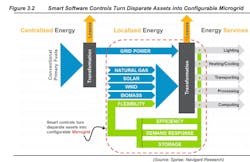Modular Microgrids: Are They the Future, Will They Liberate Microgrids?
Modular microgrids are on their way in. In fact, they boast so many benefits they could liberate microgrids.
And why exactly do microgrids need to be liberated?
It’s all spelled out in a Navigant Research whitepaper, “Liberating Microgrids (and All DER),” commissioned by Spirae, which markets a microgrid control platforms.
The problem, explained Peter Asmus, principal research analyst, Navigant Research, is that larger-scale microgrids tend to be so complex that they sometimes die in the planning process.
“They die because they are sold as complex projects and require money spent on complex engineering that doesn’t always make economic sense,” he said. They also require complex control schemes.
Modular microgrids, on the other hand, often involving a number of microgrids under 100 kW in size, are smaller, expandable and have simpler controls. They don’t have to be forced into an existing system in the form of a retrofit. And they’re easier for utilities to install. Such benefits are the key to liberating microgrids, according to the whitepaper.
“It’s easier to make modular microgrids plug and play,” Asmus said. “The smaller microgrids can run off of smart inverters, don’t need complex control schemes, and can provide more renewables and less reliance on fossil fuels.”
Modular microgrids will lead to the development of more greenfield projects, said Asmus.
“If people understand you don’t need to tie into existing diesel plants, and want to focus on just solar plus storage, those are the kinds of microgrids that will lead to more greenfield projects,” he said.
Starting with a clean slate, rather than trying to tie into existing plants, will make it easier and quicker to get microgrids–or nanogrids–up and running, he said. The latest “craze” right now in greenfield projects is solar plus storage, he said.
“In terms of greenfield projects, you see stories weekly about solar plus storage because the costs have come down so much,” he said.
The key players helping to advance modular microgrids are Tecogen, Blue Pillar and Spirae, according to Navigant. And Duke Energy’s Coalition of the Willing is helping move the market, with its goal of developing a common interoperability framework for microgrids.
Tecogen, for example, offers combined heat and power (CHP) units, and has embedded in each unit a chip with an inverter, which means that controls cost nothing, said Asmus. Some argue whether Tecogen’s unit is really a microgrid.
“The company is focused on 1 MW and below. In that category, it’s easier to make microgrids plug and play. The Tecogen unit is 100 kW. You can put three together, and then add solar and batteries,” he said.
These types of offerings will take up a growing share of the market, said Asmus. In fact, Tecogen ranked fourth in total installed microgrid projects globally last year in Navigant Research’s Microgrid Deployment Tracker. And in a separate report ranking microgrid developers that offer their own controls platform, Tecogen ranked fifth, according to a blog by Asmus.Tecogen produces InVerde, a small natural gas engine often deployed as a modular 100-kW CHP unit, according to Asmus. It includes Consortium for Electric Reliability Technology Solutions’ islanding software. The Sacramento Municipal Utility District strung some of these together to produce a microgrid. Islanding is provided by an inverter that can support a number of generators on the same microgrid. Each one can act on its own to respond to load changes and regulate power quality, for example, said Asmus in the blog.
Blue Pillar offers a modular microgrid with very little engineering. It also has a library of all existing assets, designed to help developers identify where microgrids could be developed, said Asmus.
Spirae offers distributed energy resource management systems, along with real-time microgrid control systems for electric utilities and energy service providers, according to the”Liberating Microgrids” whitepaper.
“A microgrid is simply a collection of DER that, when managed as a single system with appropriate control software, turns that collection into a virtual system with well-defined properties and capabilities. The key requirement for a microgrid is that it be able to actively manage power and energy flow within some defined ranges,” the whitepaper says.
With such systems now available, a main obstacle to more deployment of modular microgrids are issues related to connecting distributed resources to the grid, said Asmus.
“A lot of it boils down to the nitty-gritty interconnection of all distributed resources, where utilities are worried about too much solar and wind and have policies about them,” he said. However, many utilities are getting more comfortable with solar plus storage and microgrids, he added.
Modular microgrids will play an important role in the future of microgrids, but so will the bigger projects, said Asmus. “I see both things happening–smaller plug and play, but at same time, people are talking about smart cities, huge projects that will require a certain amount of complex engineering.”
Track news about modular microgrids by subscribing to the Microgrid Knowledge newsletter. It’s free.
About the Author
Lisa Cohn
Contributing Editor
I focus on the West Coast and Midwest. Email me at [email protected]
I’ve been writing about energy for more than 20 years, and my stories have appeared in EnergyBiz, SNL Financial, Mother Earth News, Natural Home Magazine, Horizon Air Magazine, Oregon Business, Open Spaces, the Portland Tribune, The Oregonian, Renewable Energy World, Windpower Monthly and other publications. I’m also a former stringer for the Platts/McGraw-Hill energy publications. I began my career covering energy and environment for The Cape Cod Times, where Elisa Wood also was a reporter. I’ve received numerous writing awards from national, regional and local organizations, including Pacific Northwest Writers Association, Willamette Writers, Associated Oregon Industries, and the Voice of Youth Advocates. I first became interested in energy as a student at Wesleyan University, Middletown, Connecticut, where I helped design and build a solar house.
Twitter: @LisaECohn
Linkedin: LisaEllenCohn
Facebook: Energy Efficiency Markets

